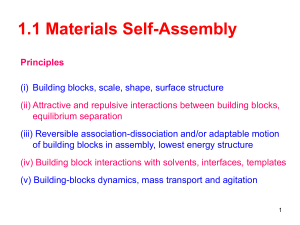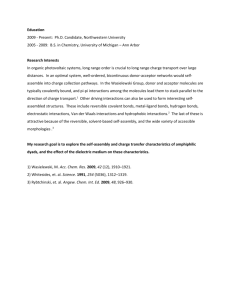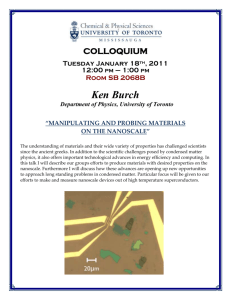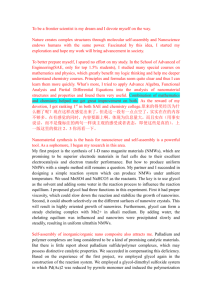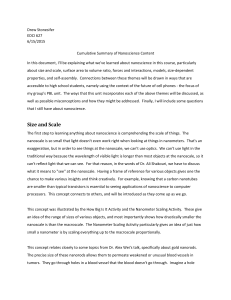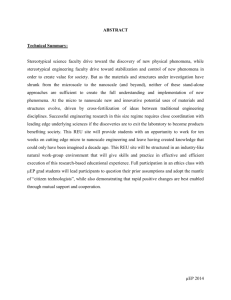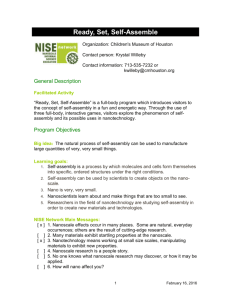Big Idea: Self
advertisement
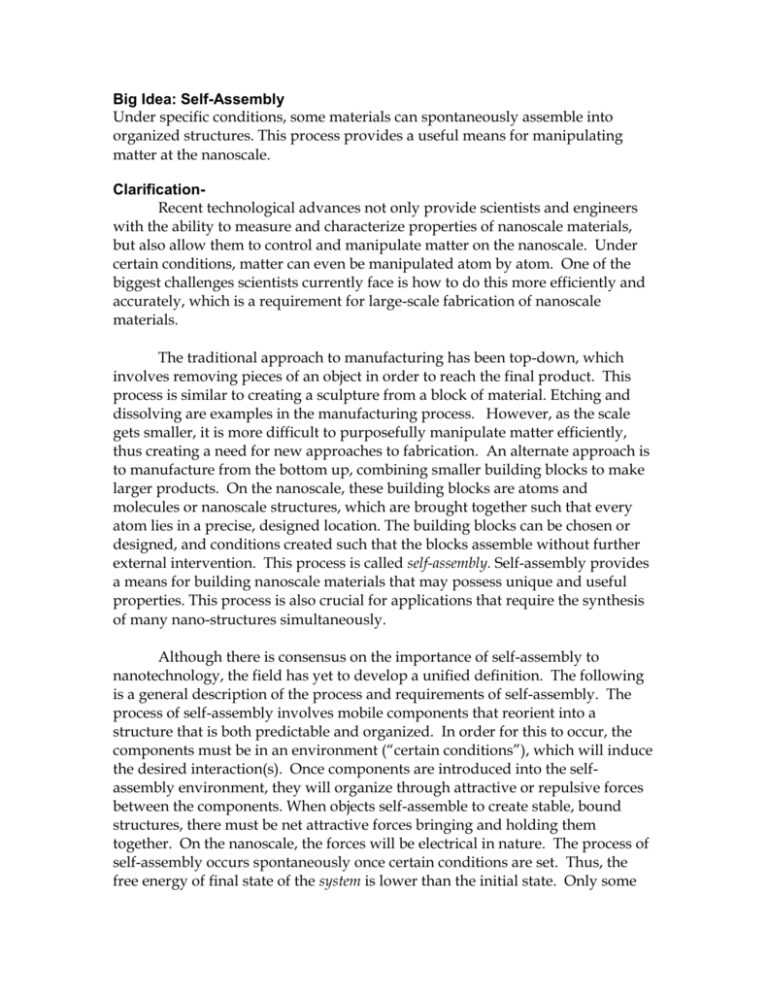
Big Idea: Self-Assembly Under specific conditions, some materials can spontaneously assemble into organized structures. This process provides a useful means for manipulating matter at the nanoscale. ClarificationRecent technological advances not only provide scientists and engineers with the ability to measure and characterize properties of nanoscale materials, but also allow them to control and manipulate matter on the nanoscale. Under certain conditions, matter can even be manipulated atom by atom. One of the biggest challenges scientists currently face is how to do this more efficiently and accurately, which is a requirement for large-scale fabrication of nanoscale materials. The traditional approach to manufacturing has been top-down, which involves removing pieces of an object in order to reach the final product. This process is similar to creating a sculpture from a block of material. Etching and dissolving are examples in the manufacturing process. However, as the scale gets smaller, it is more difficult to purposefully manipulate matter efficiently, thus creating a need for new approaches to fabrication. An alternate approach is to manufacture from the bottom up, combining smaller building blocks to make larger products. On the nanoscale, these building blocks are atoms and molecules or nanoscale structures, which are brought together such that every atom lies in a precise, designed location. The building blocks can be chosen or designed, and conditions created such that the blocks assemble without further external intervention. This process is called self-assembly. Self-assembly provides a means for building nanoscale materials that may possess unique and useful properties. This process is also crucial for applications that require the synthesis of many nano-structures simultaneously. Although there is consensus on the importance of self-assembly to nanotechnology, the field has yet to develop a unified definition. The following is a general description of the process and requirements of self-assembly. The process of self-assembly involves mobile components that reorient into a structure that is both predictable and organized. In order for this to occur, the components must be in an environment (“certain conditions”), which will induce the desired interaction(s). Once components are introduced into the selfassembly environment, they will organize through attractive or repulsive forces between the components. When objects self-assemble to create stable, bound structures, there must be net attractive forces bringing and holding them together. On the nanoscale, the forces will be electrical in nature. The process of self-assembly occurs spontaneously once certain conditions are set. Thus, the free energy of final state of the system is lower than the initial state. Only some materials are capable of self-assembling. They must possess specific characteristics (shape, charge, etc.) in order to be viable. The components of selfassembly retain the physical identity through the self-assembly process and after self-assembly. Therefore, the initial components can be isolated from the assembled structure by providing the right conditions. While self-assembly is a crucial technique for the advancement of nanotechnology, it is not a new process. Self-assembly occurs in Nature to build structures on every scale. The canonical example would be the process of assembling the DNA double helix, which proceeds with a specificity that has yet to be duplicated by scientists. In addition, some of the molecular machines that carry out crucial functions within all living organisms are built through a process of self-assembly. Thus, self-assembly is a universal concept that engineers have adopted and applied to nanoscale fabrication. Why is this a big idea? Nature utilizes self-assembly to synthesize an enormous range of structures from galaxies to biomolecular assemblies on the nanoscale. Perhaps the canonical example of self-assembly is DNA, which is a nanoscale phenomenon since the diameter of the double helix is approximately 2.5 nm. The two strands of DNA come together with a specificity that has yet to be duplicated on this scale. Each strand contains a certain sequence of four bases: Adenine, thymine, guanine and cytosine. The bases each interact with a partner in another strand—adenine with thymine, and guanine with cytosine—to form the double helix structure of DNA. The bases act as a scaffold for atoms (or groups of atoms) that participate in hydrogen bonding. They hold the atoms in a formation that complements the arrangement of the groups of atoms with the opposite polarity that are presented similarly on the opposite strand. Adenine and thymine form two hydrogen bonds when they pair, and guanine and cytosine form three hydrogen bonds upon pairing. The specificity of this simple code is such that a sequence of 16 bases or greater can select its unique, complementary strand from a sequence of DNA that is millions, perhaps billions of bases in length. Another example of nanoscale self-assembly is the formation of membranes. In this case, the building blocks (e.g., phospholipids) have a hydrophilic end and a hydrophobic end. The hydrophilic end can participate in hydrogen bonding with water, so the interaction with that end is favored over the weaker interactions (dipole-induced dipole) that occur with the hydrophobic end. Therefore in an aqueous environment, the hydrophilic ends all align such that they are exposed to the water and the hydrophobic ends are buried within. In Nature, this process creates the tissues known as biological membranes, an example of which is the cell wall. These membranes are important because they create a barrier that allows cells to maintain different chemical or biochemical environments than those of the outside. Engineers have adopted the process of self-assembly as a way to overcome the challenging problem of building nanoscale objects with accuracy and precision. The building blocks and the environment are designed such that the blocks assemble themselves without external intervention. This is an example of bottoms-up fabrication. Self-assembly is currently being used to extend the possibilities of synthetic chemistry and to build new nanoscale structures. Chemists combine large, structured groups of atoms that assemble in an ordered, symmetric manner to form ever larger (often snowflake-like) molecules called dendrimers. Synthesis of carbon nanotubes utilizes self-assembly in two ways. The synthesis of the individual nanotubes occurs via self-assembly. Once formed, the nanotubes tend to aggregate through van der Waals forces, aligning to form rope-like structures that are one of the strongest and stiffest materials known. Because of the small scale, bottoms-up fabrication is an important aspect of nanotechnology and promises to play an important role in the efforts to exploit the novel properties of matter on this scale. How can this fit into the curriculum? Self-assembly is not just a process used to advance the progress of nanotechnology; nature also uses self-assembly to build structures on every scale. The principles behind self-assembly are the same in both realms in that under certain conditions, objects assemble into an organized structure without external intervention. Thus, self-assembly is a universal concept that engineers have adopted and applied to the problem of nanoscale fabrication. The process of self-assembly presents an opportunity to build a deeper understanding of the factors that influence the strength and specificity of interactions. In the standards, shape is the primary factor considered to be important for creating favorable interactions. While shape is an undeniable influence on interactions, forces between the objects determine the strength and specificity of the interaction. This concept can be illustrated with shaped magnets. Both shape and polarity will play a role in the final assembly that the pieces adopt. <insert illustration> For example, scientists and engineers use DNA to assemble nanoscale structures by exploiting its amazing specificity. In this case, self-assembly can be used to support an understanding of the genetic code and emphasize the tremendous specificity and power that DNA affords.

